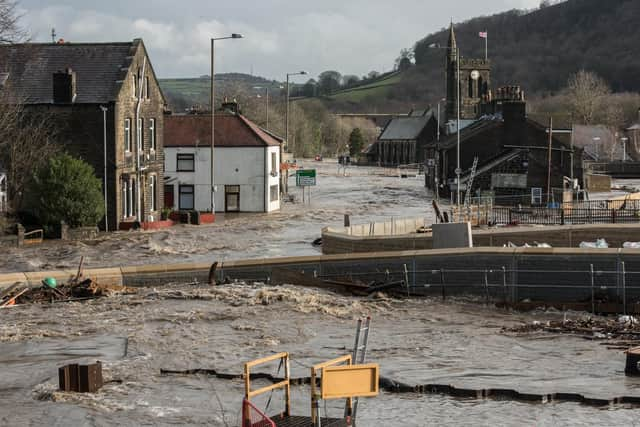Downing Street distances itself from Environment Agency claims that flood-hit communities may have to be abandoned
and live on Freeview channel 276
Sir James Bevan, Chief Executive of the agency, spoke at the World Water Tech Innovation Summit being held in London today (Tuesday).
And he said climate change “means accepting the hard truth that in a few places, the scale of coastal erosion and the risk of flooding from rivers or the sea will become so big that it may be better for communities to choose to relocate out of harm's way”.
Advertisement
Hide AdAdvertisement
Hide AdBut the Prime Minister’s official spokesman said abandoning communities was “not the advice which we're giving now”.


It is understood the focus is on spending on defences instead, and that the suggestions of moving people out of communities had not been presented to the Government as formal advice.
However the spokesman said the Government was in agreement with Sir James’ views that flood plains should only be built on as a last resort.
Sir James said flood defences worked to protect many people, and would continue to be needed, alongside measures to help communities become more resilient to increased flooding.
Advertisement
Hide AdAdvertisement
Hide AdThere is also a need for "nature based solutions", such as restoring the bends in rivers, planting trees and creating wetland habitats to slow the flow of water down river and reduce flood risks, he said.
Sir James said it would be unrealistic to ban all development on the flood plain, but it should only be done if there is no alternative, and any building that goes ahead should not increase the risk of flooding for other people.
And homes built on the flood plain should be resilient to flooding; for example, with garages on the ground floor and people living higher up.
He warned a twin track approach of defences and resilience to flooding is needed to defuse the "weather bomb".
Advertisement
Hide AdAdvertisement
Hide AdThe Environment Agency says it is spending £2.6bn on new flood defences that will better protect 300,000 properties by 2021 and more than £1bn on maintaining existing defences in England.
Communities also need help to become more resilient so that, when floods happen, they pose less risk to people, do less damage and life can return to normal more quickly, he said.
People can be encouraged to become resilient to flooding by installing measures such as flood doors, raised electrics and sealed doors.
The speech comes as communities in parts of the UK face ongoing flood threats in the wake of storms which have battered the country with high winds and heavy rain.
Advertisement
Hide AdAdvertisement
Hide AdSir James said that the aftermath of Storms Ciara and Dennis was "a stark reminder of just how devastating floods are".
"They kill people, and tragically that happened again last week. They ruin homes and damage lives. And they destroy livelihoods: some small businesses will not survive this latest blow.
"Every single flooded home or lost business is a personal tragedy, and my thoughts today are with all of those affected," he said, paying tribute to the resilience of communities and the work of EA staff.
Scientists warn that climate change is raising the risk of flooding because winter storms will bring more heavy rainfall in a warming world.
Advertisement
Hide AdAdvertisement
Hide AdSir James told the conference flood defences worked: while so far this winter around 4,000 properties have flooded, defences had protected another 85,000 homes from the flooding that they would have otherwise suffered.
"We can never protect every single household against flooding. But we can and do protect most communities most of the time," he said.
"But, in the face of the climate emergency, we now need a second, parallel, track: making our communities more resilient to flooding so that when it does happen it poses much less risk to people, does much less damage, and life can get back to normal much quicker.
"The best way to defuse the weather bomb is better protection and stronger resilience. We need both."
Advertisement
Hide AdAdvertisement
Hide AdWith many rivers, much of England is a flood plain and it is where most towns and cities are situated - so, with a growing population, the number of properties in the flood plain is likely to almost double over the next 50 years.
But while all development cannot be banned, "we can and should insist that development only happens there if there is no real alternative", does not increase other people's risk and homes are made resilient.
"Greater resilience also means designing new places, buildings and infrastructure so that they are built to cope with flooding.
"It means building back better after a flood, not simply replacing what we had before, so that homes, businesses and infrastructure are more resilient to future events.
Advertisement
Hide AdAdvertisement
Hide Ad"And it means accepting the hard truth that, in a few places, the scale of coastal erosion and the risk of flooding from rivers or the sea will become so big that it may be better for communities to choose to relocate out of harm's way.
"So not only do we need to build back better; sometimes we will need to build back in better places," he said.
England has received 141 per cent of its average February rainfall already this month, with some areas seeing a month's worth of rain in 24 hours, and record water levels seen on many rivers.